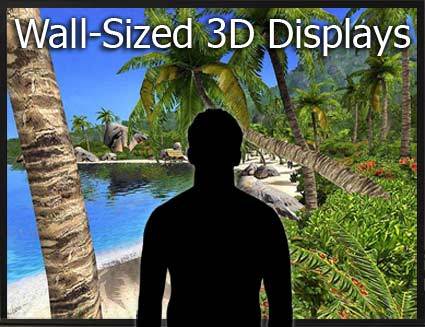Wall-Sized 3D Displays: The Ultimate Gaming Room
Introduction
There is a term you may have heard in the 1980s and '90s. It held the promise of the ultimate handshake between technology and entertainment. The term defined an idea that became very popular and actually brushed against pop culture for a time - they even made a movie or two about it. But after its initial surge of popularity, it became obvious that the technology needed to bring this concept into the hands of the public wouldn't be available for some time. The term's popularity waned, and now it's gone out of style. The term was virtual reality.
Virtual reality promised us the ability to explore virtual worlds in a way so convincing to our senses that we wouldn't be able to tell the difference from actual reality. In pop culture, virtual reality was associated with motion-tracking helmets that had 3D displays inside, with the user strapped into a gyroscope so they could move about in the virtual world without actually going anywhere.
People commonly confuse virtual reality with all of this elaborate equipment, but the concept is actually much simpler than that. Virtual Reality doesn't necessarily include a motion sensing helmet: it is simply about fooling your senses into believing you're experiencing something you're not. It is about losing yourself in the experience of a virtual world. The ultimate virtual reality wouldn't use any headgear at all - it'd be more like what we saw in the Matrix films, where you'd plug your brain into a computer and fully experience a convincing alternate reality.
Of course, we're a long way from interfacing hardware with the human brain, so we'll have to make do with what we have for now. And if you think about it, entertainment technology has steadily been moving toward virtual reality, or toward the goal of completely enveloping our senses in entertainment. Everything is becoming more immersive: we have 7.1 audio systems that completely surround us, larger widescreen televisions that take up more of our field of vision, even force feedback gamepads that give us tensile feedback. The entertainment industry has slowly been embracing the basic aspects of virtual reality without even realizing it.
It is now 2007, and immersive audio and visual technology has never been more affordable for the public. How far have we come, and how close can we get to that feeling of really "being there", while staying on a reasonable budget?
The Demise Of The VR Helmet
It's likely that at least part of the reason that virtual reality was forsaken was due to its association with the VR helmet. They didn't work that well in the 90s, they were prohibitively expensive, and let's face it... they don't look very cool. Plus, people have a natural aversion to being unable to see what's actually going on around them.
So why were VR helmets used in the first place? Well, they do have their advantages: they are a compact way to completely surround the user in vision and audio, shutting out the real world and bombarding the user's senses in virtual stimulation. Also consider that VR helmets allow for two separate displays: one for each eye. This is necessary for human stereoscopic vision, which is a fancy term for describing the way we see in three dimensions. As you can imagine, seeing in 3D is a very important part of being immersed in a virtual world - without 3D, you're just watching television.
Get Tom's Hardware's best news and in-depth reviews, straight to your inbox.
VR helmet technology has come a long way from the 1990s, but they are still hard to find, relatively expensive, and of pretty limited use. To make a convincing virtual world in the home, we need something that can display a 3D image that takes up much of the field of view, while being cheaper, commercially available, and more practical.
Current page: Introduction
Next Page The Poor Man's Virtual Helmet: Wall-Sized 3DDon Woligroski was a former senior hardware editor for Tom's Hardware. He has covered a wide range of PC hardware topics, including CPUs, GPUs, system building, and emerging technologies.
-
myrsati I bought the Acer P1303W its awsome for the price. You do have to go through a computer to get the 3D to work. I have a AMD FX 6 core proccesor and ATI 6770HD card that supports 3D. I then bought a Blu Ray 3d Internal Burner from LG for 77 bucks which is really nice. I got the Expand x102 Active glasses they are price well and look great. I thought i was screwed when the 3d didnt work when i put a blu ray 3d movie in and played it thru my Projector. My resolution was correct and at 120hz. I found out after messing around for about an hour that the software that came with my Blue Ray 3d player didnt work with my projector which is POWER DVD 9. I found a program called TotalMedia Theatre 5! As soon as i installed it and played the blu ray 3d movie and turned the glasses on everything worked!!! I had to adjust a few settings but nothing major. Dont forget not all projectors have to go thru a computer to work but you will prob pay more for them.Reply
